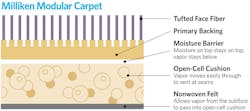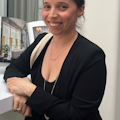When Milliken finally realized about two years ago that it never had a moisture claim come across its quality control desk, the company knew it was onto something. It was all thanks to Milliken’s moisture vapor-wicking, open-cell cushion backing that comes standard on its modular carpet tiles. “We’ve had this technology for 25 years and didn’t realize it,” said Michael Eckert, director of strategic marketing for Milliken. For its customers, the backing equals installation and maintenance benefits that can result in significant cost savings throughout the years.
Below, Eckert outlines how the construction helps to avoid one of the leading problems in the industry, making for a longer-lasting product in both design and performance.
The Perfect Combo
Milliken utilizes an open-cell, polyurethane cushion backing as opposed to a closed-cell, hard PVC or thermoplastic backing which traps vapor. “Once vapor is trapped, all it takes is a fraction of a temperature shift in that concrete slab below to make it condensate, and that’s when all of the issues begin to occur—from adhesive breakdown to mold and mildew,” Eckert explained. Milliken’s proprietary design, in conjunction with that open-cell polyurethane cushion, allows vapor to get into the backing and then escape through the seams of the tiles. There is never an opportunity to turn the vapor into liquid water.
Squashing Install Problems
A main advantage of the cushion backing is that it’s non-reactive, evading a phenomenon called “plasticizer migration” (when a PVC backing has a chemical reaction to existing adhesive) and telegraphing with thermoplastic backings where some adhesive can be seen below the tile—both of which an installer would need to rectify. Because of the thickness of Milliken’s cushion backing, any high ridges caused by adhesive problems can simply be scraped off by hand. Furthermore, carpet can be installed directly on top of any older adhesive during a renovation project.
Bonus Points
Cushion backing also provides ergonomic benefits to the end user. As many office environments move toward workstations with more sit/stand capabilities, employees will often request mats to use during standing positions. These mats provide the same attributes that are in the Milliken tiles thanks to the cushion backing. They provide acoustic benefits, as well, for open office layouts.
Longer Life Span
“Backing type plays the biggest role in wear and longevity,” Eckert noted. With a hard backing, there’s nothing to absorb the shock from foot traffic on carpet tiles and a lot of the wear goes directly into the fiber. “Cushion is a shock absorber. If you have the cushion to absorb that impact it makes a substantial difference in lifespan. Our products last approximately 12 to 15 years, while the useful life of a PVC-backed product is around seven, and thermoplastic around five. It’s a beauty contest on the top, but people don’t realize how much backing can play into it.”
Photography courtesy of Milliken
About the Author
AnnMarie Martin
Editor-in-Chief
AnnMarie is the former Editor in Chief of i+s and has been covering the commercial design space. Her style and vision has helped the brand evolve into a thought leader in purpose-driven design and cultural movements shaping the way we live and work.

